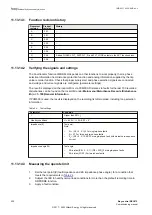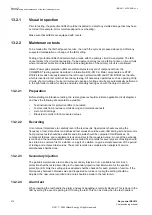
voltage regulation. Smaller values may lead to a normal state where tap changers for parallel
transformers are well out of step, and values significantly higher will cause over-sensitivity in
the voltage control function and tap changer hunting behavior. It is an important outcome of the
testing process that the compensating factor is checked for each transformer to ensure
sensitive but stable operation for circulating currents.
For example, if there are three transformers connected in parallel, and the tap changer of
transformer T1 is two steps over the tap changer of T2 and T3, the circulating current detected
by the VCTR for T1 will be the sum (with opposite sign) of the current measured at T2 and T3.
The currents measured at T2 and T3 will ideally be about the same values. If the voltage is
close to the upper limit of the
UDeadband
, the tap changer of T1 will try to decrease the
controlled voltage. In the opposite case, that is, the voltage is close to the lower limit of
UDeadband
, the tap changer at T1 will not try to decrease the controlled voltage. The tap
changer for T2 and T3 will not operate due to the fact that the detected circulating current will
be half of the current detected at T1. The setting of the parameter
Comp
then might need to be
increased a little. At least one tap changer step difference between the different transformers
should be allowed in order to avoid the tap changers to operate too often. If the allowed
difference is, for example, two steps, the tap changer shall be stepped up three steps when
setting the parameter
Comp
.
10.
Set the
Comp
parameter for T2 and T3 in the same manner as for T1. According to the
described procedure when the tap changer of one transformer is two steps above the others, it
shall automatically step down. When there are only two transformers in the group either shall
one step down or the other step up depending on the voltage level at the ATCC.
12.1.4
Master Follower (MF) method
SEMOD176327-244 v5
The Master Follower method requires a Master to be nominated in a parallel group. It is responsible
for measuring secondary bus voltage and executing commands to raise and lower tap changers,
which are repeated by Follower transformers in the group.
1.
Confirm the voltage blocking levels
OVPartBK
and
UVPpartBK
in
Main menu/Settings /IED
Settings/Control /TransformerVoltageControl(90, U↕)/TR8ATCC(90, U↕||):x/Voltage/
Umax,Umin
.
2.
Check that
MFMode
is set to
Follow Tap
or
Follow Cmd
in
Main menu/Settings/IED Settings /
Control/TransformerVoltageControl(90, U↕) /TR8ATCC(90, U↕||):x/MFMode
.
If this setting is
Follow Tap
, all Follower transformers shall match the actual tap setting of the
Master, while
Follow Cmd
requires that Follower transformers follow the RAISE and LOWER
commands executed by the Master.
3.
Confirm the maximum difference in tap positions for parallel transformers. The number of taps
is determined by the setting in the Parameter Setting tool under
Main menu/Settings/IED
Settings/Control/TransformerVoltageControl(90, U↕) /TR8ATCC(90, U↕||):x /ParCtrl/
MFPosDiffLim
4.
Connect all transformers in the parallel group to the same busbar on both the primary and
secondary sides.
5.
Set the control mode to
Manual
for each transformer in the parallel control group
6.
Open the test display for Transformer Voltage Control on the LHMI in
Main menu /Test/
Function status /Control/TransformerVoltageControl (90, U↕)
.
Section 12
1MRK 511 403-UEN Rev. L
Primary injection testing
210
Bay control REC670
Commissioning manual
© 2017 - 2022 Hitachi Energy. All rights reserved
Содержание REC670
Страница 1: ...Relion 670 SERIES Bay control REC670 Version 2 2 IEC Commissioning manual ...
Страница 2: ......
Страница 28: ...22 ...
Страница 54: ...48 ...
Страница 60: ...54 ...
Страница 66: ...60 ...
Страница 90: ...84 ...
Страница 212: ...206 ...
Страница 218: ...212 ...
Страница 232: ...226 ...
Страница 240: ...234 ...
Страница 241: ...235 ...
















































